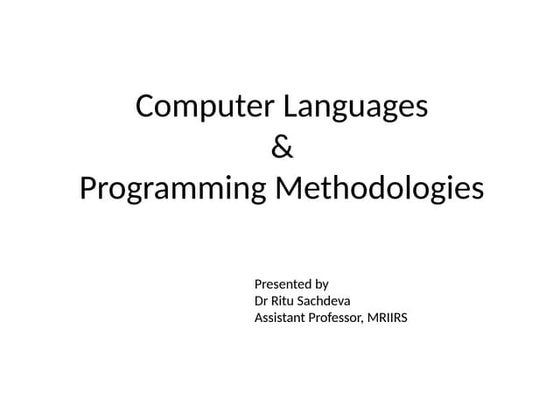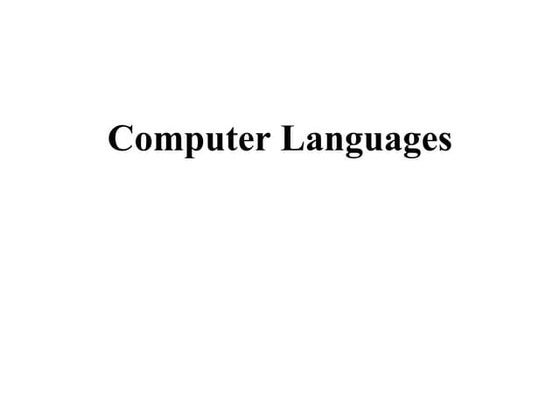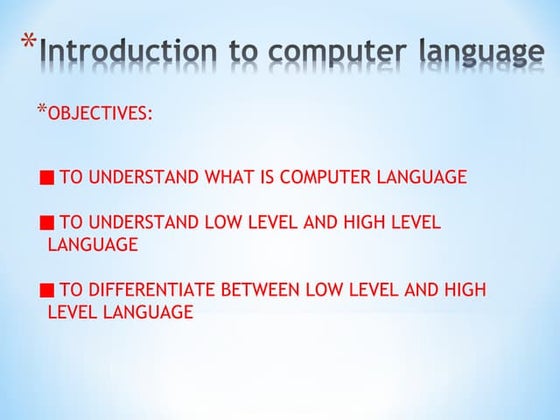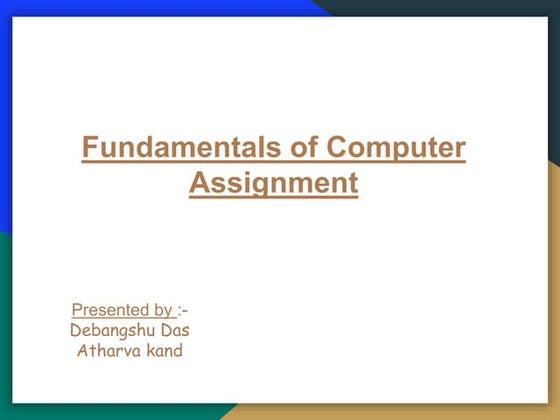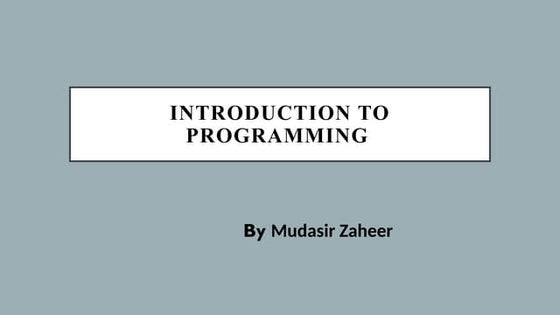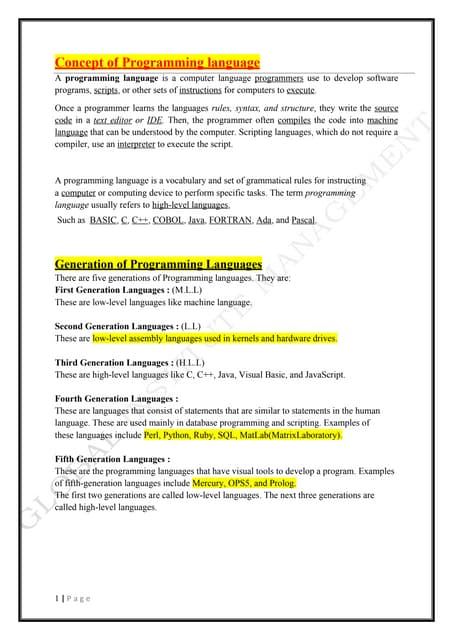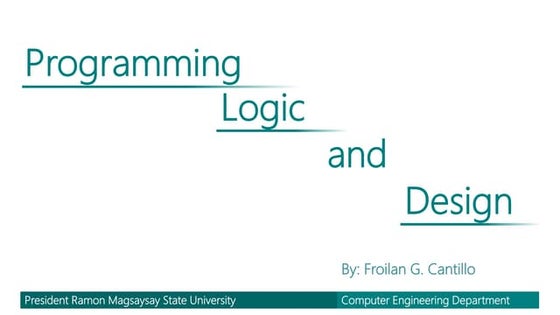Lec21&22.pptx programing language and there study
- 1. Programming Languages and Their Comparative Study
- 2. Computer programming ŌĆó Computer Programming is defined as the process of creating computer software using a programming Language. Computer programs are written by Human individuals(Programmers) ŌĆó A computer program is a step by step set of instructions that a computer has to work through in a logical sequence in order to carry out a particular task. The computer executes these instructions (obeys the instructions) when told to do so by the user.
- 3. Programming Languages ŌĆó Programming languages are the vocabulary and set of grammatical rules for instructing a computer to perform specific tasks. There are many different types of programming languages each having a unique set of keywords (words that it understands) and a special syntax (grammar)for organising program instructions. ŌĆó There are many computer programming languages and so the programmer will have to decide which one to use for solving a particular problem. These languages must be learnt just as Swahili, English or French etc.
- 4. Syntax ŌĆó Syntax refers to the spelling and grammar of a programming language. Each program defines its own syntactical rules that control which words the computer understands, which combinations of words are meaningful, and what punctuation is necessary. Text-based programming languages are based on sequences of characters, while visual programming languages are based on the spatial layout and connections between symbols (which may be textual or graphical).
- 5. Syntax Example ŌĆó #include <studio> ŌĆó int main( void ) { ŌĆó printf( "Welcome to C!n" ); ŌĆó return 0; ŌĆó }
- 6. Levels of programming languages ŌĆó Programming languages are classified into five major categories: ŌĆó Machine languages (first generation languages) ŌĆó Assembly languages (second generation languages) ŌĆó Third generation languages ŌĆó Fourth generation languages ŌĆó Natural languages. ŌĆó Machine and assembly languages are referred to as low level languages; third generation, fourth generation and natural languages are categorised as high level languages.
- 7. Low level vs high level language ŌĆó A low level language is machine dependent; that is, it is written to run on one particular computer. A high level language is machine independent, which means the high level language code can run on many different types of computer. ŌĆó There are two types of low-level programming languages: Machine Language and Assembly Language.
- 9. Machine language ŌĆō First Generation Language (1GL) ŌĆó The machine language writes programs using the machine code of 1s and 0s, which is directly understood by the computer. This makes the language suitable for the understanding of the machine but very much more difficult to interpret and learn by the human programmer. ŌĆó The main problems with using machine code directly are that it is very easy to make a mistake, and very hard to find it once you realise the mistake has been made. ŌĆó There was originally no compiler or assembler to process the instructions in 1GL.
- 10. Characteristics of 1GL Advantages ŌĆó No translator is required ŌĆó The programs written in these languages utilize the memory in an efficient manner because it is possible to keep track of each bit of data. ŌĆó Fastest to execute because it is already in the language that the computer can understand Disadvantages ŌĆó Difficult to interpret (requires the aid of a reference manual to interpret the meaning of each code) ŌĆó Easy to make mistakes in the sequence of 1s and 0s; replacing a 1 for a 0 can result in the wrong command/instruction being executed ŌĆó It is difficult to identify mistakes made ŌĆó Time-consuming and tedious to write ŌĆó Machine dependent ŌĆó Programming becomes more difficult as the complexity of the program increases
- 11. Assembly language ŌĆō Second Generation Language (2GL) ŌĆó Assembly language is written using mnemonic codes (abbreviated English words) or short codes that suggest their meaning and are therefore easier to remember. ŌĆó Assembly language contains human-readable notations that can be further converted to machine language using an assembler(converts assembly level instructions to machine level instructions.) ŌĆó These codes represent operations, addresses that relate to main memory, and storage registers of the computer. Typical codes might be: LDA, STO, ADD, NOP, etc. ŌĆó Assembly language are a necessary bridge between the underlying hardware of a computer and the higher-level programming languagesŌĆösuch as Python or JavaScriptŌĆöin which modern software programs are written.
- 12. Example An example of a program code to add and store two numbers would be: ŌĆó LDA A, 20 : load accumulator A with the value 20 ŌĆó ADD A, 10 : add the value 10 to accumulator A ŌĆó STO B, A : store contents of accumulator A into storage register B ŌĆó NOP: no operation (stop here) ŌĆó An accumulator is a type of register included in a CPU
- 13. Characteristics of 2GL ŌĆó As with machine language, assembly language is machine dependent. ŌĆó Assembly language, being machine dependent, is faster and more efficient in the use of hardware than high-level programming languages. ŌĆó Assembly languages have to be translated into machine language by language translators known as assemblers for the processor to understand. ŌĆó Easier to write than machine language ŌĆó The code is not very easy to understand, hence the introduction of high level programming languages.
- 14. Assemblers and Compilers ŌĆó Assemblers and Compilers are programs that convert high level languages into machine code. ŌĆó The assembly-language program must be translated into machine code by a separate program called an assembler. The assembler program recognises the character strings that make up the symbolic names of the various machine operations, and substitutes the required machine code for each instruction. ŌĆó A Compiler is a program that converts the entire source code(compiles it) into machine language at one time before the computer can run the program at a later time. While compiling the source code into machine code, it checks that the syntax is properly written by the programmer for the programmer to debug the program.
- 15. How a Compiler works
- 16. Interpreters ŌĆó The interpreters are programs that translates the high level program code one statement at a time, that is, it reads a code statement, converts it to one or more machine language instructions, and then executes the instruction before moving translating the next code statement in the program. If there is any error in the statement, the programmer can correct the error before the interpreter evaluates the next statement. ŌĆó Interpreters are slower than Compilers because interpreters convert a statement at a time and runs it before moving to the next line.
- 17. How an Interpreter works
- 18. High-level programming languages High level programming language is defined as one that is machine independent and uses variables and objects, Boolean expressions, functions, loops, arrays, threads, locks which are similar to their meaning (abstraction). ŌĆó High-level languages have evolved over the years and can be grouped into categories: Third Generation Languages (3GL), Fourth Generation Languages (4GL), Object Oriented Programming Languages (OOP), Fifth Generation Languages (5GL) and Scripting Languages
- 19. High-level programming languages ŌĆó These languages are problem oriented, so they are machine independent. ŌĆó Since high-level languages reflect the logic and procedures used in a human algorithm, the programmer is able to concentrate on developing task algorithms rather than on how the computer will carry out the instructions. ŌĆó the programmer must still specify a complete set of detailed instructions. The words and grammar of high-level languages are English-like and this makes the programs more readable and easy to write.
- 20. Characteristics ŌĆó A high-level language is governed by a strict syntax (set of grammatical rules). ŌĆó they are easier to read, write, and maintain. ŌĆó They also permit faster development of large programs. ŌĆó programs written in a high-level language must be translated into machine language by a compiler or interpreter. ŌĆó They are machine independent hence portable ŌĆó They are user friendly and easy to learn ŌĆó They are more flexible hence they enhance the creativity of the programmer, increasing productivity ŌĆó They are executed much slower than low-level programming languages
- 21. Third generation languages ŌĆó The third generation is also called procedural language /3 GL. It consists of the use of a series of English-like words that humans can understand easily, to write instructions. Its also called High-Level Programming Language. For execution, a program in this language needs to be translated into machine language using Compiler/ Interpreter. Examples of this type of language are C, PASCAL, FORTRAN, COBOL, etc. ŌĆó Advantages of third generation programming language ŌĆó It is easy to develop, learn and understand the program. ŌĆó As the program written in these languages are less prone to errors they are easy to maintain. ŌĆó The program written in these languages can be developed in very less time as compared to the first and second generation language ŌĆó Same code can be copied to another machine & executed on that machine by using compiler-specific to that machine
- 22. Third generation languages Disadvantages : 1. Compiler/ interpreter is needed. 2. Different compilers are needed for different machines.
- 23. Fourth Generation languages The fourth-generation language is also called a non ŌĆō procedural language/ 4GL. It enables users to access the database. Examples: SQL, FoxPro, Focus, etc. The fourth generation programming languages were designed and developed to reduce the time, cost and effort needed to develop different types of software applications. These languages are also human-friendly to understand. Advantages : 1. Easy to understand & learn. 2. Less time required for application creation. 3. It is less prone to errors. Disadvantages : 1. Memory consumption is high. 2. Has poor control over Hardware. 3. Less flexible.
- 24. Fifth generation languages ŌĆó The fifth-generation languages are also called 5GL. It is based on the concept of artificial intelligence. It uses the concept that that rather than solving a problem algorithmically, an application can be built to solve it based on some constraints, i.e., we make computers learn to solve any problem. Parallel Processing & superconductors are used for this type of language to make real artificial intelligence. ŌĆó Example: PROLOG, LISP, etc. Advantages : 1. Machines can make decisions. 2. Programmer effort reduces to solve a problem. 3. Easier than 3GL or 4GL to learn and use. Disadvantages : 1. Complex and long code. 2. More resources are required & they are expensive too.
- 25. Major high level programming languages used ŌĆó FORTRAN (FORmula TRAnslator)developed in the late 1950s developed to design scientific applications ŌĆó COBOL (Common Business Oriented Language) developed in early 1960s to develop business applications. ŌĆó RPG (Report Program generator) was developed in early 1960s to assist in generating reports and complex calculations.
- 26. Major high level programming languages used ŌĆó BASIC (BeginnerŌĆÖs All-purpose symbolic instruction code) developed in mid 1960 Basic versions include MS-BASIC, QBASIC, SmallBASIC and visual basic. ŌĆó Pascal was developed in the late 1960s for the purpose of teaching structured programming concepts ŌĆó C developed in the early 1970s to write system software ŌĆó Ada was developed in the late 1970s originally developed to meet the needs of embedded computer systems
- 27. Major high level programming languages used ŌĆó C++ developed in the 1980s is an object-oriented language mainly to develop application software ŌĆó Note that in addition to the major languages discussed above, there are many other programming languages that have been developed such as JavaScript, and Python
































